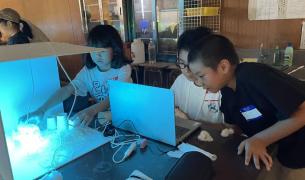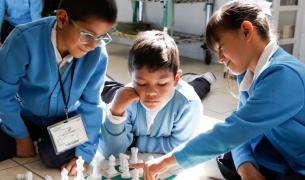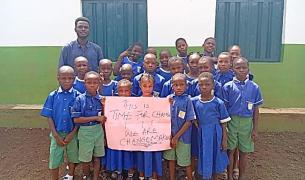Community-Led Change: A Conversation Between the CEOs of Anseye Pou Ayiti and Teach For Armenia

Last month, Anseye Pou Ayiti (Teach For Haiti) hosted a learning trip for a group of leaders from across the Teach For All network to explore the topic of community-led change. Beginning in Cap Haitien and travelling across the country to Port-Au-Prince, the group immersed itself in Haitian history; visited communities where Anseye Pou Ayiti works to meet with students, teacher-leaders, program alumni, and community partners; and drew connections between their experiences in Haiti and their own local contexts. Together the group explored the core questions Where is the seat of power? Who leads change? and How do language, culture, and tradition factor into our approach? The following is an excerpt from a conversation between Anseye Pou Ayiti’s CEO, Nedgine Paul Deroly, and the CEO of Teach For Armenia, Larisa Hovannisian in which they reflect on the experience and their perspectives on the importance of community-led change.
Larisa Hovannisian: In Haiti, we experienced first-hand how fundamental community-led change is to Anseye Pou Ayiti’s approach. From the beginning, you and your team have really understood what community-rootedness means for you, and for Haiti, which has inspired me to think differently about my own context here in Armenia.
Nedgine Paul Deroly: At the heart of Anseye Pou Ayiti is the belief that those who have experienced inequity should be leading the movement for change. We’ve continued to ask the question of how do we disrupt the power structures that allow certain people to stay in control and others to be marginalized? The thing about community-rootedness that I get really excited about is that we’re working to redefine leadership as rooted in collective action—which is a lesson from successful social movements in Haitian history as well. Recently, I came across a quote by Maya Angelou that says “I come as one but stand as 10,000.” And it just reminds me of the power of what collective action will look like when it doesn’t matter who’s the one who stood up, but that all of a sudden it’s 10,000 of us standing in unison.
LH: I personally took away a lot of specific lessons. For example, how you think about who needs to be leading, how you reflect that in your strategy, and how you think about scale. How do you feel this conversation about community-rootedness and community-led change is evolving within the network?
NPD: One of the things that I hope will continue to evolve over time is that this cannot be a siloed conversation. I think if community rootedness can be at the heart of all of our work, it has the potential to unleash so much in our global movement for change. One thing that reminds me that we’re heading in the right direction and having the right conversations at Anseye Pou Ayiti is when those conversations are uncomfortable. The “nice to-dos” are the tweaks around the edges that maybe shift a couple of outcomes. But if we’re focused on really shifting the status quo, it usually leads to different team conversations.
I also hope our classrooms become microcosms of the communities we envision. At the end of the day, they are one and the same. So we need to think about how we can be even more courageous, more daring, about the things that we do in our classrooms, because that’s the only way we can be modeling the change that we aim to see in the community.
LH: What do you hope the other CEOs and I continue thinking about after experiencing Anseye Pou Ayiti’s approach?
NPD: There are a few things. The first is that we all need to sit in the “messy truth” that is our history and our current day. Sometimes we all get lost in the many different interweaving components of our work. Or we try to simplify the issue or focus on the feel-good, positive elements. But I think some of the darker aspects of this work need to be confronted, because if we don’t confront them we’re going to be having the same conversations 10 and 20 years from now. To sit in the messy truth that is the context that creates educational inequity is so important to us in solving it.
Another takeaway I hope is that it’s never too late to steep ourselves in history and in community. It’s never too late to lift up the dignity and the leadership of the people who we say we serve and who we walk alongside.
LH: Exactly. All of our countries have a historical past, and I think the biggest takeaway for me from our visit is that history is just so important. We have to know what we’ve been through in order to understand where we are today, why we are this way, and where we want to go.
NPD: What else are you taking away from the experience?
LH: A similarity between our contexts that really struck me is that kids are kids. They have the same dreams and hopes. Listening to Anseye Pou Ayiti students talk about how they’re so worried about the environment and how trees are getting cut down, and how they’re recycling and picking up bottles from the street, and modeling good citizenry and good behavior—those are all things kids in Armenia talk about too. It’s just unbelievable how similar kids are around the world and how their dreams and hopes are just hopes for a better world. I hope that more and more we can facilitate connecting points and conversations between our teachers and our students, because there’s just so much organic alignment.
Also, what Anseye Pou Ayiti has identified to be the core grounding anchors of their work—culture, customs, and community—is just so aligned with Teach For Armenia. These are all embedded in our work but it’s almost like I needed to go to Haiti to recognize it and come back to say, “We are actually doing so many of these things.” What I think we haven’t yet done enough of is to crystalize and talk explicitly about those values.
NP: I think for all of us, to really be an authentic movement and to be recognized as such, it has to come up from a place of deep conviction. It is our incredible students, teacher-leaders, and community members on the front lines of this work—they believe and they are the ones who remind us every day of our belief that transformation is possible. We have done it before, and we can do it once again.
LH: Yes. I think we need to understand that this is a very long journey and we need to gear ourselves up for the long haul. Short-term solutions are not relevant in this work, because it’s a continuous journey. We also need to understand that it cannot depend on one person or three people. Like Maya Angelou said, it needs to be an army of 10,000.
Learn more about Anseye Pou Ayiti and Teach For Armenia.



